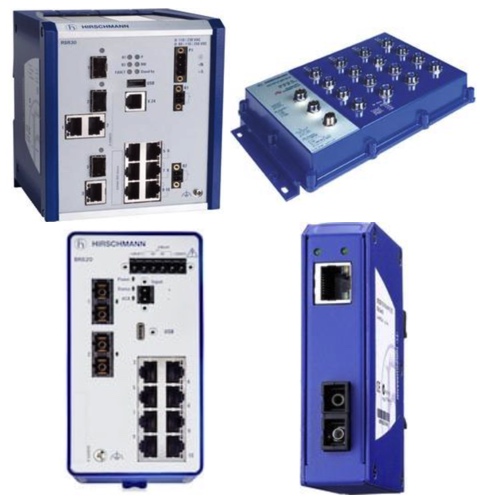Hirschmann Ethernet Switches

The reliability, durability, and intelligent design of Hirschmann Ethernet switches are well-suited for industrial Ethernet networks. Their performance in the "most demanding" operating environments has made them the go-to choice for many firms across sectors such as energy, transportation, and manufacturing. Vibration, temperature extremes, and electrical noise are no match for these Ethernet switches.
Hirschmann switches also offer a key advantage with their modular design, which allows for tailored configuration of the particular switch to specific network demands. Unmanaged, network-managed, and power-managed switches are available in various models that support multiple interchangeable media modules for flexible connectivity options and management features. Still, the most consistent feature of these Ethernet switches is their extreme reliability and reduced likelihood of failure, especially when using the supplied industrial power supply designed to deal with the sorts of voltage fluctuations that can often be an issue in industrial setting.
More Information about Hirschmann Ethernet Switches
Hirschmann’s managed switches increase the likelihood that the industrial networks they serve will remain not just functional but also protected, efficient, and reliable. High-speed industrial Ethernet networks are now capable of carrying the kinds of data that require not just a secure connection but also a quick one if the network is to serve its purpose. Hirschmann’s managed switches communicate with the network at lightning speed and are also robust enough, thanks to their rugged construction, to be put to work in harsh industrial environments where dust, dirt, moisture, and vibration may exist as real threats and where resilient cybersecurity is more necessary than ever.
FAQs
What makes Hirschmann Ethernet switches better than other brands?
What sets Hirschmann Ethernet Switches apart from other brands is their proven reliability in harsh industrial environments, along with advanced management features and redundancy protocols that ensure uninterrupted data communication under demanding conditions.
Are Hirschmann Ethernet switches designed for fast Ethernet?
Yes, Hirschmann Ethernet switches are designed for Fast Ethernet and Gigabit Ethernet applications, offering high-speed data communication suitable for industrial and automation networks.
Do Hirschmann switches need special software to configure them?
Most managed Hirschmann switches can be configured via a web browser interface, CLI (command line), or the free HiDiscovery tool, which will locate connected devices.
What is the difference between unmanaged and managed Hirschmann switches?
Unmanaged Hirschmann switches are plug-and-play, with no configuration needed, while managed switches provide management features like diagnostics, VLANs, security, and redundancy settings.
Are Hirschmann switches compatible with fiber and copper media types?
Yes. Many Hirschmann switches support modular media modules allowing copper, multimode fiber, or single-mode fiber uplink options to be selected for flexible connectivity.
4 things to consider when selecting Ethernet switches
Should the switch be managed or unmanaged?
Unmanaged switches receive data from connected devices and route it to the desired destination. Managed switches perform the same functions as unmanaged switches, with the added benefit of being able to configure, manage and monitor the Local Area Network (LAN).
What types of devices will be connected to the switch and do they require power?
If the devices require power, a Power Over Ethernet (POE) switch will be needed. This type of switch provides power to the devices that are connected to it, as long as those devices are designed for the same type of power. This is very common in IP cameras and surveillance equipment.
How many devices will connect to the switch?
Ensure that the switch has enough available ports to accommodate all devices, with spare ports available for future expansion.
How much data will the switch transfer?
If the switch is going to handle large amounts of data, it is going to need to operate at high enough speeds to accommodate it. The most common options are Fast and Gigabit. Fast allows up to 100 megabytes per second to be transferred, while Gigabit allows up to one Gigabit per second.

